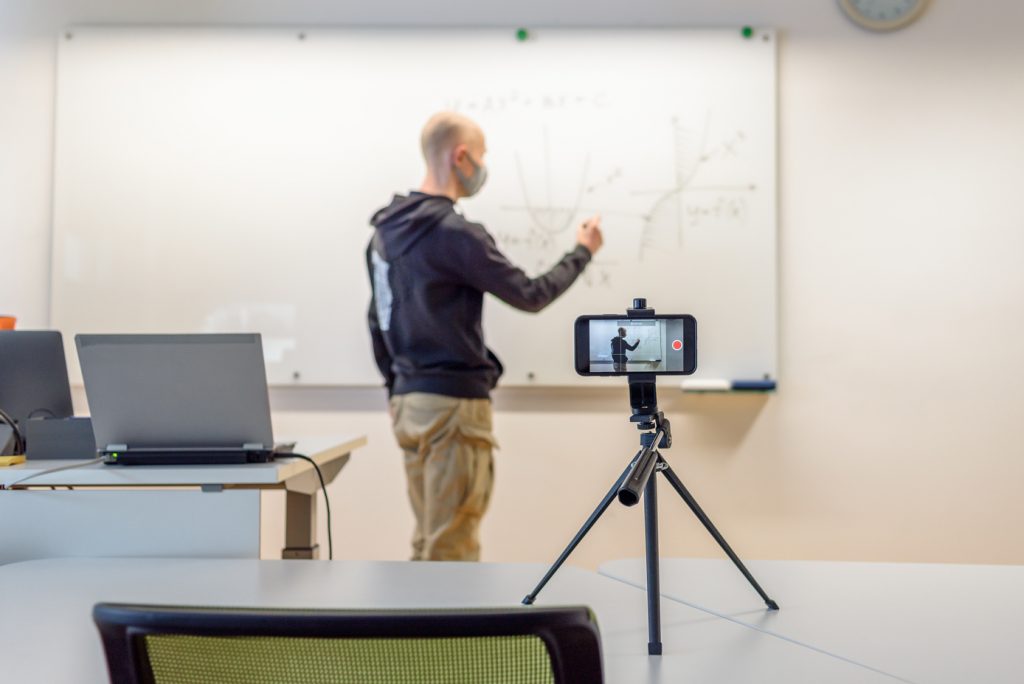With the new wave of Covid-19, educators and students alike are finding themselves in virtual classrooms instead of physical classrooms. In this article, we provide insight on how you, as an educator, can be more effective when teaching online.
Imagine you are a student and want to learn a new topic such as beekeeping. Consider the difference between reading a textbook or participating in a live lecture (sans live bees!). The two mediums are very different and, as Marshall McLuhan famously captured in his phrase “the medium is the message,” the differences heavily influence the style of teaching and learning.
Virtual teaching, by definition, restricts the medium to audio, video, slides, chat, and whatever other interaction tools you have within the virtual classroom. In contrast to a physical classroom, which has traditional cues for insight into the class, students in the virtual classroom invariably feel more distant. The same is true for the teacher.
However, despite the distance, your intellectual and emotional connection to students need not become equally distant. Let’s use the beekeeping example again. We typically don’t think of the beekeeping textbook and lecture as mutually exclusive – they both cover the same content, but because they are different mediums, they require different skill sets to master as the educator. You can imagine the textbook author needing different skills to be an effective teacher in a physical class (and vice-versa). In a similar manner, teaching online requires a different set of skills to master – though the same pedagogic theories and practices are shared between virtual and physical classes.
If we think of online education as a different medium, then how can you be more effective in this medium? The question starts with looking at effective online teaching.

Being a passionate and effective educator means remaining a student forever; it means understanding how to bring your content to the learner in ways that engage, inspire, and teach them within the strengths/weaknesses of the medium.
According to Rhonda Bondie, researcher at Brown University and writer for Harvard’s GSE (Graduate School of Education), the qualities of an effective online teacher include possessing:
Bondie acknowledges that technology in online learning helps to thread together these four components of decision-making.
“Teachers also need cultural awareness to ensure that their curriculum and teaching practices are both relevant and sustaining, and they need content knowledge to ensure that the technology-rich activities enable students to develop accurate conceptual understandings. Isolated technology skills that are not aligned and integrated into the teacher decision-making base are often unused or not used effectively during teaching”
Rhonda Bondie
Bondie is saying that technological skills (or lack thereof) that are not aligned with the medium of the virtual classroom will not yield effective teaching. The reverse is also true. The stronger you are in technological skills applying to online learning, the better you have to achieve effective online engagement.
While there are many tools to help set up a better online classroom experience, the efficacy of such tools lies chiefly on the educator using it. To return to the beekeeping example, the author of a venerated beekeeping textbook must be both a competent writer and Apiarist. In a similar manner, an educator who envisages a successful online learning experience through technology must also be both a competent educator and utilizer of technology. Even if your technological skills are not where you would like them to be, having a great handle on the pedagogy can put you in a much more favourable position than those who don’t.

So what can you do as an educator? Some driving principles of effective online teaching include:
Based on the above driving principles, educators should be cognizant about creating more opportunities for engagement:
Effective online engagement requires increasing your engagement with the virtual class beyond what you would normally do in the physical classroom. To use an analogy with filming a scene in a movie, the actors are subtly and skillfully accentuating their movements, body language, and voice to communicate with the viewer through the limited medium of audio and video.
As a teacher in a virtual class, you may be self-conscious about engaging more than normally in a physical classroom, but in the online class, where the medium is more narrow, you need to more overtly engage students to compensate.
From the student’s point of view, a common struggle is fewer ways to connect with the teacher, leading to a sense that the teacher does not care about their success. Consider the humanity of your learners through:
These activities give your students a sense of your empathy to their needs. The effort is worth it, as the American Psychological Association (APA) notes that:
“Teachers who experience close relationships with students reported that their students were less likely to avoid school, appeared more self-directed, more cooperative and more engaged in learning”
American Psychological Association

It’s an unfortunate reality in our world that students can be treated as numbers rather than what they actually are: human beings. Faced with constant pressures that challenge their well-being such as bullying and poverty, there is a needed responsibility on behalf of educators to operate with empathy and compassion in the classroom.
Kate Brierton, a psychologist at Cambridge University, explains the importance of compassion in organizations and why it should be a focus for educators. In her webinar Compassionate Schools: A Whole School Approach to Wellbeing, it’s noted that
“Increased levels of compassion within an organisation can help all members to thrive, achieving optimum levels of creativity, motivation and performance.”
Kate Brierton
Virtual classes come with their own variety of pitfalls that, with much preparation, consistent practice, strong determination, and a dash of ingenuity, your chances of encountering these traps are slim. It is important to be aware of them to avoid falling into them:
Aside from the pandemic, as our world becomes more connected, the paradigm of education will undoubtedly encompass more online teaching and learning.
As educators, the opportunity (and onus) is to master the medium to the benefit of the student. As Rhonda Bondie, Harvard Graduate School Director of professional learning and education lecturer, writes:

“…teachers need to make deliberate decisions about how students will feel belonging in a classroom community in a space without walls, see themselves reflected in the virtual space, feel both independence and belonging, and share power dynamics intentionally.”
Rhonda Bondie
In summary, online education requires a student-centric approach, emphasizing content, pedagogy, and assessment, enhanced through technology. Each of these components requires planning and sound feedback-informed decision-making.
Such mastery will require risk-taking, courage, and investment of time. As a teacher the rewards are great, and for your students, the rewards are even greater. For in the end, while the medium of virtual classrooms is narrower than the physical classroom, its reach is global, enabling you to both magnify your skills as a teacher and to improve the lives of students anywhere in the world.